| Vài cái tên khác | Dao cắt giấy, Lưỡi chém giấy, Dao chém, Dao máy chém |
|---|---|
| Nguồn gốc | Trung Quốc |
| Ứng dụng | Nhựa, Giấy, Bảng, Phim, Giấy bạc, Nhãn, Bao bì, Tôn, Tạp chí, Sách |
| Vật liệu | 65Mn,9CrSi,Cr12MoV,SKD-11,HSSl |
| Số mô hình | GP-GB |
| Dịch vụ OEM | Có sẵn |
| Điều khoản thanh toán | L/C, T/T, Western Union |
| Bưu kiện | Hộp carton, trong hộp gỗ |
| Thời gian giao hàng | 7-20 ngày |
Chia sẻ với:
Guillotine blades, also known as guillotine knives or straight cutting blades, are long, straight cutting tools used in guillotine cutters or shearing machines. These machines are designed to make straight, precise cuts across a wide range of materials, most commonly paper, cardstock, and thin boards in the printing and paper converting industries, but also metals, plastics, and other materials in industrial shearing applications. The term “guillotine blades” refers to the straight blade or set of blades that descend in a shearing motion to cut the material held firmly in place.
Guillotine blades are essential tools in various industries for making clean, straight cuts. Key applications include:
The materials used for guillotine blades must be durable, wear-resistant, and capable of maintaining a sharp, straight cutting edge to ensure clean and accurate cuts over extended use. Common materials include:
The blades are precision ground and often hardened and tempered to achieve the optimal balance of sharpness and durability. The bevel angle of the cutting edge is critical for the specific material being cut, ensuring a clean shear without tearing or crushing.
Guillotine blades are typically long and straight, but variations exist in their edge profiles and overall design depending on the application and the material being cut:
The working principle of guillotine blades involves a powerful downward shearing motion against a stationary bed or anvil. The material to be cut is held firmly in place by a clamp, and the sharp, straight blade descends with significant force, cleanly severing the material. The length and thickness of the blade, the angle of the bevel, the force applied, and the rigidity of the machine all contribute to the quality and accuracy of the cut. Proper sharpening and alignment of the guillotine blades are essential for optimal performance and safety.
Chào mừng bạn đến hỏi thăm!
Nếu bạn không tìm thấy lưỡi cắt bạn đang tìm kiếm, chúng tôi cũng có thể tùy chỉnh nó, hãy xem “Lưỡi tùy chỉnh“ để học cách làm!
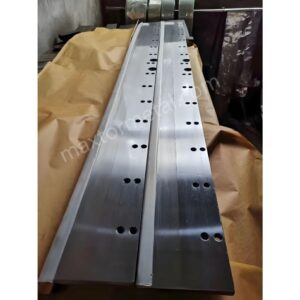



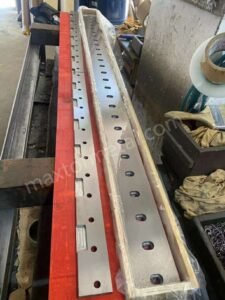
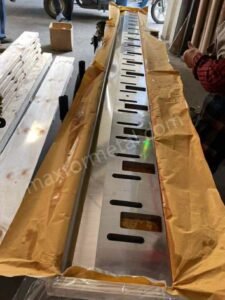
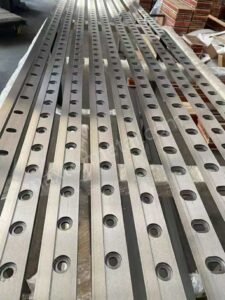
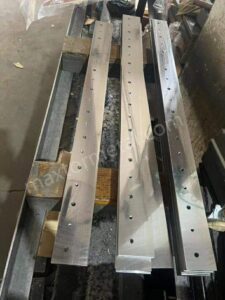
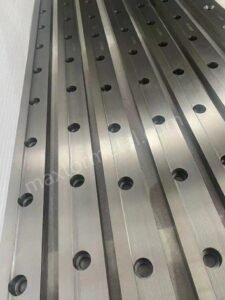
Dễ dàng tận hưởng sự tiện lợi khi nhập khẩu, từ khâu vận chuyển đến thông quan, chúng tôi xử lý toàn bộ quy trình, bạn chỉ cần trả thuế VAT và chờ hàng về công ty.
Chúng tôi đã thấy các lưỡi dao của nó được sử dụng trong vô số ứng dụng và sẵn sàng xử lý bất kỳ dự án nào bạn thực hiện theo cách của chúng tôi - mang lại độ chính xác, độ bền và mức giá cạnh tranh chưa từng có.
Cho dù bạn cung cấp bản vẽ, phác thảo hay mẫu, chúng tôi đều có thể vẽ và sản xuất cho bạn. Chúng tôi cũng có khả năng hỗ trợ sửa đổi các thiết kế và thông số kỹ thuật hiện có để cải thiện hầu hết mọi ứng dụng công cụ công nghiệp. Vui lòng liên hệ với đội ngũ bán hàng tận tâm của chúng tôi để thảo luận về các yêu cầu cụ thể của bạn.
Một loạt các thử nghiệm và kiểm tra được thực hiện để kiểm soát chất lượng, bao gồm kiểm tra sản phẩm đầu tiên, kiểm tra vật liệu đầu vào và vật liệu được chứng nhận, kiểm tra chất lượng trong quá trình, kiểm tra chất lượng cuối cùng.
Cho dù bạn là nhà nhập khẩu, nhà phân phối, nhà bán buôn hay người dùng cuối, chúng tôi đều hoan nghênh bạn tham gia cùng chúng tôi với MOQ tối thiểu, không gặp rắc rối khi tìm hiểu thông tin và tự do hơn khi mua hàng.
Trở thành người giám sát độc quyền của bạn, truyền tải thường xuyên mọi nút quan trọng trong dây chuyền sản xuất, bất kể ở xa đến đâu, tiến độ của sản phẩm đều được nắm bắt càng sớm càng tốt!
CÔNG TY TNHH CÔNG NGHIỆP Metal Nam Kinh
Khu công nghiệp Mingjue, Lishui, Nam Kinh, Giang Tô, Trung Quốc
Luôn cập nhật với những tin tức mới nhất của chúng tôi.